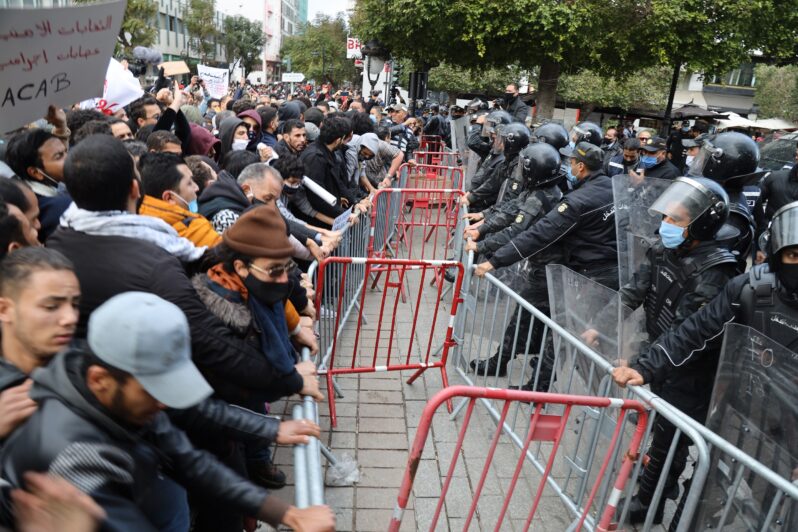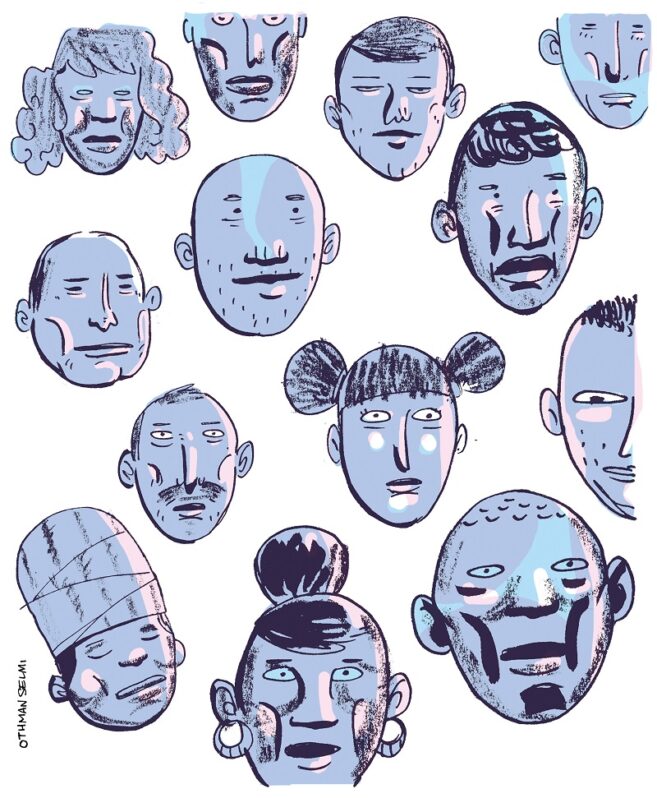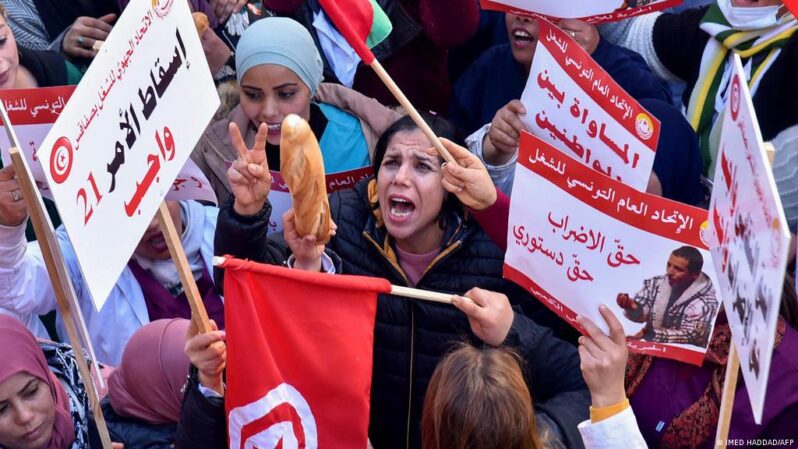Tunisia: Barricading Revolution Avenue

Police barriers have devoured much of Habib Bourguiba Avenue at an alarming rate. There is a feeling that every morning a new barricade is erected by the police and defense agencies, cordoning off new sections. A meticulously planned police and political war is being waged on a vital artery of public space that still retains its “revolutionary allure”. The avenue now resembles a massive barracks around which civilians are permitted to wander, take souvenir photos, and perhaps deliver statements on social media.
Some side streets, such as Rue Houcine Bouzaiene, have also paid the price of their proximity to the Ministry of Interior building. They were closed years ago and removed from the city map. Cafes neighboring the police fortress lost their customers and character and resigned themselves to isolation, surrounded by barriers and no-standing signs. When the sociopolitical climate heats up, a political decision is made to close Habib Bourguiba Avenueand it becomes the site of fierce clashes between protesters and police. After July 25, the barriers extended to encircle Municipal Theater Square and fence in the square containing the Ibn Khaldun statue, which is guarded by armored vehicles. The city’s historian and philosopher is now encircled by barriers, and Tunisian poet Mohamed Sghaier Ouled Ahmed’s verse “O Ibn Khaldun, the city is too narrow for your footsteps” has become truer than ever before.
When the Fortress of Fear Shook
In the cold winter of 2011, the avenue of informal meetings, under close police surveillance, was preparing for an exceptional moment that would turn it into a global spectacle and part of the country’s rebellious history. On 26 January 1978, the forces of regime repression had blocked access to Habib Bourguiba Avenue and sniped many unarmed protesters in the neighboring streets and squares.[1] But on 14 January 2011, the angry masses, unsatisfied with the dictator’s last-minute speech, managed to remove the barbed wire and barriers to storm the avenue from all sides.
Authorities seek to suppress a great lesson for the people, namely that the awe-inspiring gray fortress can be reached. It cannot withstand long against angry people’s unity and determination. For the first time in the country’s history, thousands gathered before the Ministry of Interior building. On its part, the police system – even after Zine El Abidine Ben Ali’s departure – absorbed the shock and comprehended its future effects. It therefore endeavored to fortify the Ministry of Interior building and the surrounding streets with barricades and barriers, gradually occupying approximately half the avenue.
January 14 was a climactic moment in which several meanings and implications converged. While the revolution was a “great societal discussion”, in the words of Fuad Khalil,[2] the avenue was at that moment a junction where the periphery and center united involuntarily and without prior coordination, and a diverse social mass (practitioners of free professions, officials, merchants, students, unemployed people, hawkers, the city’s paupers, and so on) gathered. The desire to repossess the street was an expected consequence of the desire to reclaim the people’s usurped rights: their dignity, freedom, and the human right to equality. This element seems to be the most disconcerting part of the story for the repressive system because the avenue’s liberation from its surveillance and control meant that it had lost its authority, which feeds off surveillance and prohibition.
Reclaiming the Avenue, Reclaiming Power
In the early months of 2011, Habib Bourguiba Avenue transformed into a square for public debate – a clamorous, cheerful Tunisian agora. It became a destination for hawkers, popular dishes, and graffiti. The marginalized urban masses created their revolutionary carnival during a short-lived moment of authoritarian fragility. The spectacle was generally humiliating for a steel police administration predisposed toward “crackdowns” and “checking IDs and documents”.
French philosopher and architect Paul Virilio said that the principal function of totalitarian regimes is to “manage political traffic”.[3] This description may match the system of police repression in Tunisia, which saw the revolutionary moment as traffic chaos that required rearranging and reactivating mechanisms of cordoning and control. The last hawker was expelled from Habib Bourguiba Avenue before summer 2011, security barriers began springing up like mushrooms, and police cars and checkpoints began taking over. The political discourse dominant since 2011 justified this closed security architecture on the basis of “combatting terrorism”. In reality, “prohibition” and “terrorism” coexist in Habib Bourguiba Avenue, with the most prominent example being two suicide bombings in 2018 and 2019. Generally, the barriers have not prevented the explosive belts, but they have helped control demonstrations and subdue protest movements.
The machine of prohibition and control over Habib Bourguiba Avenue has been renewed since the October 2011 elections. The post-revolution governments resumed the attempts to regain control over the avenue at every opportunity. Hamadi Jebali’s government (the government of Ennahda and its allies) subdued the marches on 7 and 9 April 2012 in a manner only explained by a desire to suppress opposing opinion. The post-2014 governments produced by Nidaa Tounes’ rise to power continued by repressing peaceful assemblies held by the I Do Not Forgive campaign, which opposed the financial and economic reconciliation law. Hichem Mechichi’s government, too, subdued the youth protests in Habib Bourguiba Avenue and prosecuted many of the activists in January 2021. The post-July 25 authority relies on closing and limiting access to the avenue via excessive shows of police force. Days after President Kais Saied seized all powers, activists and journalists endured attacks by security forces in the avenue despite their small numbers. The desire to establish a tighter grip over authority went hand in hand with a desire to dominate the avenue and neutralize it from the political struggle.
The avenue evokes suspicion from the regimes and governments because January 14 ended people’s phobia of the “fortress of fear”. It demonstrated that the avenue where the Ministry of Interior building stands can be breached by the masses when anger, unity, and a just cause combine. Hence, the police administration of the avenue expresses a continuous political desire to extend and consolidate power via an urban space architecture based on police control and routine police measures such as checking pedestrians, blocking traffic in many parts of the avenue, and sometimes barring all entry.
The Avenue as a Struggle of Symbolisms
Victors always strive to inscribe their symbols within a place, so that physical domination is accompanied by a symbolic and cultural one connected to conscience and memory. The name “Habib Bourguiba Avenue” itself reflects the triumph and domination of a certain symbolism connected to the first post-independence president, who saw the nation as an extension of his glory and personal battle. The place and the leader’s image thereby fuse. To this day, the name “Habib Bourguiba Avenue” is still invoked despite competition from the names that have officially been given to the large square overlooking the avenue: “November 7 Square” in the era of the Ben Ali regime and “January 14 Square” after the 2011 revolution. Even the name “Revolution Avenue”, repeated by many media and political elites, has not become popular in common parlance.
In the context of the struggle over the avenue’s symbolism, the last Bourguibist ruler – late president Beji Caid Essebsi – managed to return the statute of President Bourguiba on horseback to the avenue in 2016. The restoration of Bourguibist symbolism after 2011 was part of the power struggle and a tool of ideological mobilization against a competing ideological vision represented by the Islamists. The current authority seeks to erase January 14 from collective memory, deeming it a “fake” revolutionary moment. Hence, President Saied issued a decree that replaced January 14 as Revolution Day with December 17. This narrative of the revolution intersects the old system’s narrative, which deems January 14 an “inauthentic” moment hatched by foreign intelligence agencies and influential foreign media.
Meanwhile, there were footprints made in Revolution Avenue on 14 January 2011 that all the authorities are trying to crush and erase. There is a “great societal discussion” that brought together different social groups and generations that still recall their small victory and broad disappointment. Amidst the large symbolic and political retreat of all dreamers of change, the language of security barriers has prevailed and reimposed its traffic rules on the subjects. But security checkpoints are not invincible. The stronger the popular movement to occupy the street becomes, the more the barriers and barricades fall.
This article is an edited translation from Arabic.



